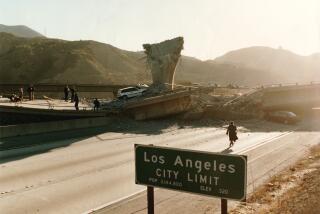Column: Most of us are not ready for a major earthquake. This guy can help — and maybe save your life

Trent Sanders, a retired L.A. County sheriff’s deputy, remembers the raw power of the 1971 Sylmar earthquake and the wicked punch of the 1994 Northridge quake.
Both of them were frightening, destructive and deadly.
But neither of those was the Big One.
“Are you ready?” Sanders asks in an earthquake-preparation checklist he has repeatedly emailed to friends, neighbors and family members, many of whom have forwarded the advice to their own pals. His ideas aren’t necessarily original, but they’re neatly compiled, and last week, he posted them on his Facebook page.
“Every time there’s an earthquake, he sends a reminder,” said Julia Wood, a public health nurse who lives in Long Beach. “Even if it’s not an earthquake, but a disaster somewhere in the world, he reminds us we have to be ready.”
With monster hurricanes in the news, along with two killer quakes in Mexico, Sanders has been busy. At 76, he is a human early-warning system.
Sanders said it’s obviously critical for cities to do what they have to do. In short, they need to follow the lead of Los Angeles, Santa Monica and San Francisco, which have ordered retrofitting of the most vulnerable kinds of buildings. The televised rubble in Mexico and the collapse of a concrete building were horrific reminders of the urgency to move quickly.
But Sanders, whose public service didn’t end with his retirement, wants to make the point that individuals need to do their own part. And that denial or procrastination could have lasting consequences.
We all know where we live and what the risks are. California is a banged-up specimen with a curved spine and head-to-toe fractures, mugged by time, and the worst beatings may be yet to come. And still it’s so easy not to be ready, or to pretend we’re in good shape by throwing a flashlight and a few cereal bars into a bag and then forgetting where we stashed it.
Not Sanders.
“Here it is, right back here,” the lanky retiree said as he escorted me to a backyard storage bin the size of a mini-Cooper.
Don’t put your stash in the house or garage, Sanders said, because there will be fires after a magnitude 7 or 8 beast. Water supply lines may rupture and buildings will burn to the ground.
Stacked and layered inside his earthquake shed are lanterns, propane tanks for his barbecue grill, a portable shower contraption, first-aid equipment, vacuum-packed MREs (Meals Ready to Eat), coffee, canned goods, bags of rice and enough beans to fire a rocket into orbit.
“After Northridge and Sylmar, the supermarkets were just denuded of everything,” said Sanders. “And people weren’t prepared for that.”
Some people can barely afford to shop for this week’s meals, let alone stash away food that may never be eaten. But if there’s widespread devastation, emergency supplies may not be available for days, so Sanders encourages people to do what they can.
I don’t think he’s being alarmist, either. Earlier this year, when I toured the San Andreas fault with earthquake queen Lucy Jones, she reminded me that transportation, power, water, gas and communication arteries could be ruptured in a 7.8 jolt. Skyscrapers could topple and countless buildings might be declared uninhabitable.
Jones also noted that just because your house is bolted doesn’t mean it’s properly secured. Standards have changed dramatically over the years, so get your home checked by an established contractor who specializes in seismic safety.
“Count on there being no water,” Sanders says on his advice sheet, advising people to stockpile enough to last several weeks, figuring on one gallon per person daily. And you need to plan for some kind of latrine system, he said, with plenty of toilet paper in your prep kit.
If roads are out, you might not be able to leave the area, Sanders said. Even if you could, gas pumps might not work. And don’t expect your cellphone to function, said Sanders. So you need to plan ahead on how to rendezvous with family.
He recommends designating a friend or relative out of the area that everyone can call when they get to a working landline, so families can keep tabs on one another. Also, if you’re a push-button dialer who doesn’t memorize important phone numbers, keep a written list in your purse or wallet.
Sanders said he keeps some cash on hand, hidden away, because ATMs won’t operate in a power outage, and anyone who requires regular medication should keep an emergency supply on hand.
Ed Phelps, who lives across the street from Sanders, is a former city councilman who helped draft La Cañada-Flintridge’s earthquake preparedness plan. He already had an emergency food supply and several large drums of water in storage at his home. But after getting Sanders’ list, he added a few items. Among them, a portable stove, a camping shower and a generator that can run a refrigerator.
“When your house catches fire and you dial 9-1-1, you’re going to get a busy signal,” said Phelps. “In L.A., we could be talking about a catastrophic quake, and Trent’s right. It’s going to be like Florida, where four and a half million people were without electricity.”
Another person who has heeded Sanders’ warnings is his sister, Carla Johnson, who lives in the Glenoaks Canyon neighborhood of Glendale. She has a 55-gallon water drum, food supplies and a duffel bag with flashlights, batteries, a whistle to call for help and a crowbar in case she has to pry her way out of a damaged house.
“We’ve got over 700 houses up here and there’s a concern that if the overpass from Highway 2 comes down, we’d be trapped and have to hike out,” Johnson said.
I asked if her brother, the former deputy, has always been a persistent guy — and, in this case, kind of a town crier.
“That’s him,” she said. “And the older he gets, the more he gets that way.”
In his backyard, Sanders had one last piece of advice for all of us.
“Don’t be paranoid,” he said. “Be prepared.”
Here are some quake tips:
Preparing your home for The Big One.
Tips to be ready for the next major quake.
Getting beyond quake anxiety and into positive action.
Get more of Steve Lopez’s work and follow him on Twitter @LATstevelopez
More to Read
Start your day right
Sign up for Essential California for news, features and recommendations from the L.A. Times and beyond in your inbox six days a week.
You may occasionally receive promotional content from the Los Angeles Times.







